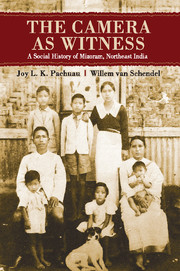Book contents
- Frontmatter
- Contents
- List of Figures
- List of Maps
- Acknowledgements
- I Becoming Mizo
- 1 Introduction
- 2 Coming into View: The First Portraits
- 3 Adjusting Mizo Culture
- 4 Domesticating a New Religion
- 5 Getting Educated
- 6 Controlling the Hills
- 7 The Trouble of Travel
- 8 First Stirrings of the Market Economy
- 9 Mizos in the World Wars
- 10 Mizo Visual Sensibilities
- II Mizoram in the New India
- III Visions of Independence
- IV Mizo Modernities
- Copyrights and Sources
- Glossary
- Bibliography
- Index
10 - Mizo Visual Sensibilities
from I - Becoming Mizo
Published online by Cambridge University Press: 05 May 2015
- Frontmatter
- Contents
- List of Figures
- List of Maps
- Acknowledgements
- I Becoming Mizo
- 1 Introduction
- 2 Coming into View: The First Portraits
- 3 Adjusting Mizo Culture
- 4 Domesticating a New Religion
- 5 Getting Educated
- 6 Controlling the Hills
- 7 The Trouble of Travel
- 8 First Stirrings of the Market Economy
- 9 Mizos in the World Wars
- 10 Mizo Visual Sensibilities
- II Mizoram in the New India
- III Visions of Independence
- IV Mizo Modernities
- Copyrights and Sources
- Glossary
- Bibliography
- Index
Summary
Cameras spread quickly in Mizoram, leaving us an impressive visual record of life in the region. Early on, photographs began to cluster around certain popular genres with which Mizos were comfortable. In this chapter, we will consider some genres that express their sensibilities in a particularly meaningful way.
There are many ways in which Mizo photographs resemble the popular use of the camera the world over. Many images in our collection focus on family groups, individual portraits, life-cycle events and happy moments of sociability. But in Mizoram there are also genres that are unusual and their emergence brings out the ways in which photography gets locally inflected and put to work to specific cultural ends. It is four of these that we introduce in this chapter: the dead and the living; massed groups; Christmas/New Year and personal wheels.
We do not claim to present an overview of Mizoram photography, if only simply because we do not know what our collections fail to cover. The few genres we selected for presentation here struck us as revelatory of how Mizos decided to use the technology offered by the camera. They call attention to how Mizos expressed themselves visually and what photography meant to them. We concentrate on early examples, although these genres jelled into enduring traditions.
The dead and the living
In pre-colonial Mizoram, physical markers were important to reinforce the sense of the dead continuing to be present among the living. Memorial stones, gravestones and shrines were ubiquitous. The photograph became a new marker of this relationship. At the same time, it showed how this relationship was expressed in new ways.
Figure 10.1: Hranglianchhingi's grave in Dawn (photographer: R. A. Lorrain, 1914). Figure 10.1 exemplifies a mix of pre-colonial and colonial funerary traditions. It displays the stone that marked the grave of a young woman from the village of Dawn who died in 1911 at the age of 21.
- Type
- Chapter
- Information
- The Camera as WitnessA Social History of Mizoram, Northeast India, pp. 212 - 230Publisher: Cambridge University PressPrint publication year: 2015

